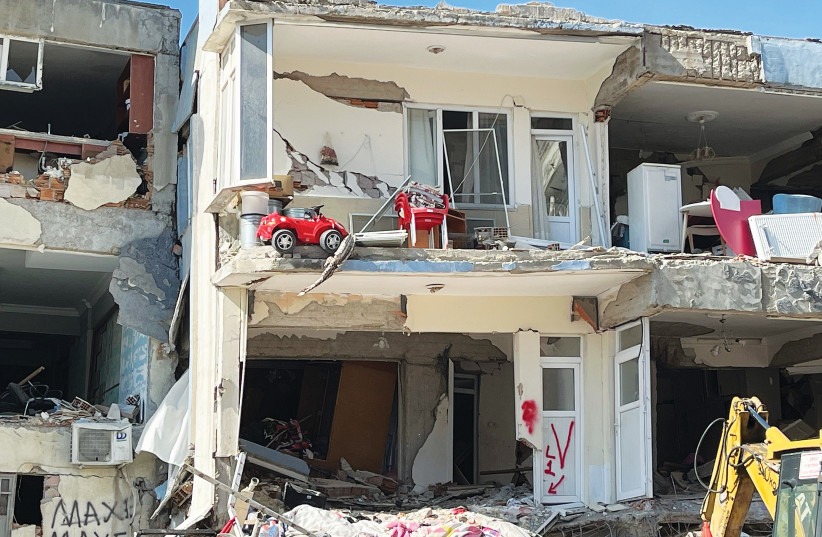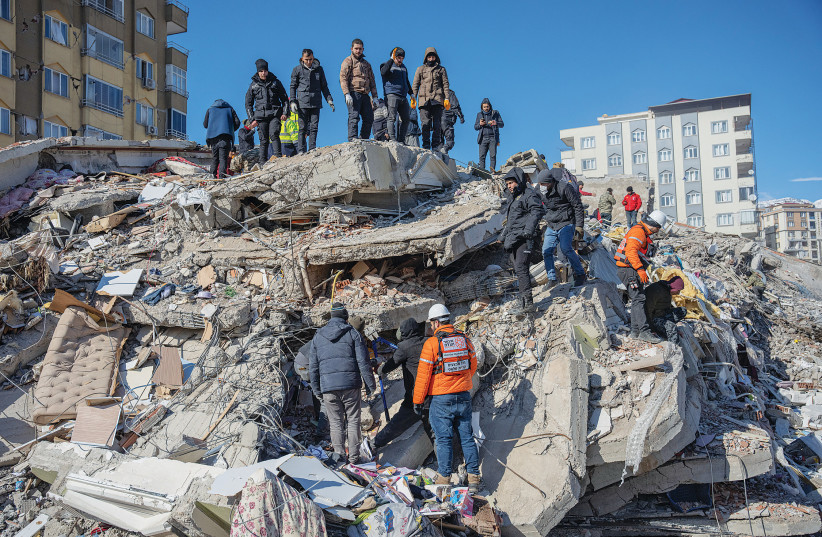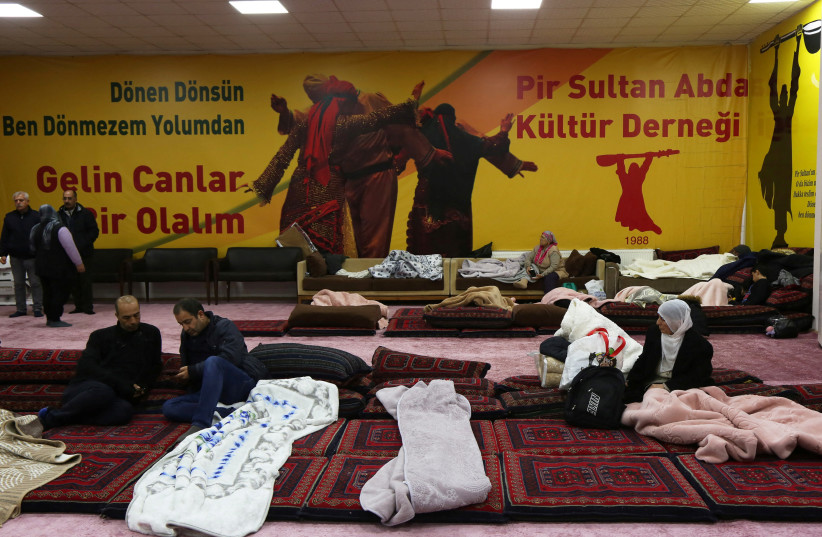Horror and beauty at the Turkey earthquake ground zero

REGIONAL AFFAIRS: The 'Post’s Michael Starr reports from the center of Israeli rescue efforts in the aftermath of the Turkey earthquake.
KAHRAMANMARAS, Turkey - A disaster site is a place of both horror and beauty. I was struck with this as I walked through Kahramanmaras the day after Monday’s earthquakes that also ravaged northern Syria.
The situation in Kahramanmaras proved civilization to be very fragile. The city, if it's still possible to call it that, was at the epicenter of the earthquake. The roads are now impassable messes of asphalt. This has increased the difficulty for emergency workers to reach the affected areas, and for survivors to flee.
The city at the epicenter of the earthquake
Driving along the roads is slow and turbulent, and solemn – roads are lined with tents for the homeless. In the cities, cars were crumpled by falling debris. Some were flipped over when the tremors began. Forklifts were being used to clear them from the road.
Other transportation has been affected as well. Flights in and out of Turkey are in disarray. We were greeted at the Gaziantep airport by a mass of people seeking to join family elsewhere, or to get anywhere that wasn’t there.
When entering Kahramanmaras, it was easy to see why.
Apartment buildings have collapsed in on themselves; each floor has become like a stratum in a rock formation. While strata can be studied to learn of ages past, each layer told the story of a home. Scraps of life hung out from the stacked slabs of stone, bedding, drapes and carpets fluttering in the wind.
Now and again I spotted children’s toys. They burn into your mind like the afterimage of the sun, if you stare at it directly – two pink bears, on top of each other like the concrete slabs of the collapsed buildings, a red plastic car hanging precariously off the edge of an exposed apartment.
Some belongings pulled from the remains of these homes were collected at a tennis court for the former residents to sift through.
I helped a crying woman struggling with the few sackfuls of belongings she had, which included a carpet and a bag of diapers. She didn’t speak English, but she did her best to express her gratitude despite her tears, after we reached the site where she and her family had set up camp, only a few hundred meters away.
The internally displaced would huddle around small campfires, burning whatever lumber or flammable material they could salvage. They layered themselves with whatever clothes they could, wearing blankets and carpets like cloaks – anything to protect against the unyielding cold and ruthless wind.
Cold is more than just a bother
Snow and ice still glazed some fields as rescue operations began. If the earthquakes and aftershocks weren’t enough — periodic tremors continued into Thursday — the winter storm front that froze Israel had battered Turkey as well. At night, the frigid temperatures were unbearable without a hat or gloves. People had no shelter, no protection from the elements. Cold is a different beast when there is no prospect of walls to protect you; instead of a bother that harries and nips, it slowly gnaws you to death.
The buildings that were still standing were structurally unsound. Locals feared to venture inside lest the buildings collapse under the wounds suffered during the initial quakes, or be felled by one of the many aftershocks that plagued the region. Even if the brave or desperate did seek shelter inside, the buildings had massive holes gouged out of their faces, which rendered them useless to protect against the cold and wind.
The fierce winds cut even deeper than the cold, also kicking up plumes of dust that had been created from the collapse of so many buildings. Each gust blinded rescuers and residents. Everybody, their faces and hair, were covered in the thick dirt.
While the un-trapped injured had already been evacuated from the city, death lingered. The sounds of men and women wailing were incessant. It was the dirge of loved ones’ broken bodies being uncovered. Black body bags were occasionally carried through the streets, battered residents the weary pallbearers.
When rescuers dug deep enough into rubble, the putrid smell of death would escape. I saw one man hanging out, torso and legs, between two floor strata. The rest of him remained concealed between two concrete slabs.
“It was difficult to see,” Yossi Cohen, commander of United Hatzalah’s Turkey relief mission, said of the situation in Kahramanmaras, where his teams worked to save as many as they could. “You think first about your family. But you’re on an international mission. The situation is difficult. The fact that you see kids, so many families torn up, and they have so long to go – and you’re only here for a minute.”
EVERY TURK I spoke to in Kahramanmaras had lost someone in the disaster or knew someone who had.
And yet, even at this epicenter of death and suffering, it was in these people that I found beauty. Though they had lost almost everything, the little that they had they were willing to give to each other and the rescuers.
Tarkan, a young Turkish man, offered to United Hatzalah to translate for them. To a member of the IsraAID team that had come to assess long-term aid needs, he offered his meal of bread and soup.
Another woman, who didn’t know whether her brother and his family were alive or dead in a collapsed building nearby, asked whether there was anything she could do for the rescuers.
One man came with water bottles filled with warm soup and offered them to an IDF search and rescue team.
Men and women, young and old, unaffiliated with organizations, went through the streets passing out bread, juice boxes and cookies to survivors. Other civilians supplied red hats that likely came from government relief.
I saw an elderly man struggling to carry a crate of water bottles. I signaled to him that I would help him carry it to where he had set up camp. We went a few meters before a translator explained to me that the old man wanted me to help instead by passing out the bottles to the homeless locals. He waved goodbye and trudged on, leaving me to my new task.
When their strength was needed, they lent to one another whatever their cold, battered, weary bodies could muster.
Twice I saw how, when a car had to be removed from the road for tractors and construction equipment to pass, the people of Kahramanmaras worked together to push it to a benign position.
When IDF rescuers were trying to figure out how to free a trapped family, and a call went out for carjacks, the people of Kahramanmaras rallied again. They ran through the streets, some breaking into abandoned cars. Before long the work crew did not lack for carjacks; a large pile of them formed outside its work site.
There were arguments, to be sure, about why some received aid before others, or why residents helped one family but not another, but they were few, and people worked together to calm those who were troubled.
“The generosity is a real testament to the community on the ground, despite the brutal conditions, cold and lack of shelter,” said IsraAID’s Mali Bernstein. “It’s an inspiration to see their resolve. Even though they don’t have much materially, they are still willing to share with the community.”
Bernstein said that it is in hard times that we see the true character of people.
The people of Kahramanmaras have undergone the harshest of times, but in that great hardship, the deepest truth of their character has been revealed – and it is true beauty.
To donate to United Hatzalah’s ongoing emergency efforts in Turkey, go to www.Israelrescue.org/earthquakeresponse/. To donate to IsraAID’s long-term emergency aid projects, go to https://secure.givelively.org/donate/israaid-us-global-humanitarian-assistance-inc/israaid-emergency-response-fund?utm_source=turkiyemedia
Jerusalem Post Store
`; document.getElementById("linkPremium").innerHTML = cont; var divWithLink = document.getElementById("premium-link"); if (divWithLink !== null && divWithLink !== 'undefined') { divWithLink.style.border = "solid 1px #cb0f3e"; divWithLink.style.textAlign = "center"; divWithLink.style.marginBottom = "15px"; divWithLink.style.marginTop = "15px"; divWithLink.style.width = "100%"; divWithLink.style.backgroundColor = "#122952"; divWithLink.style.color = "#ffffff"; divWithLink.style.lineHeight = "1.5"; } } (function (v, i) { });




